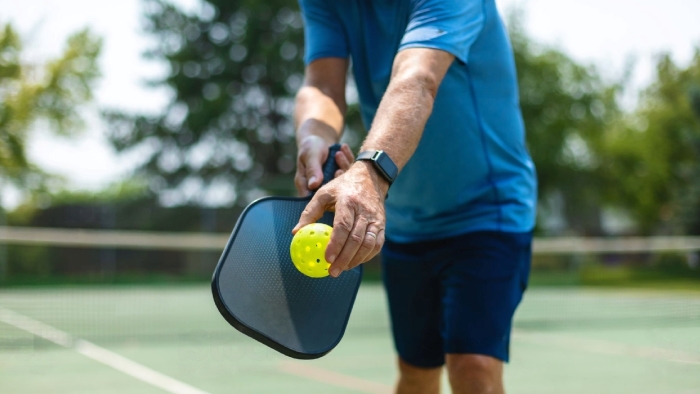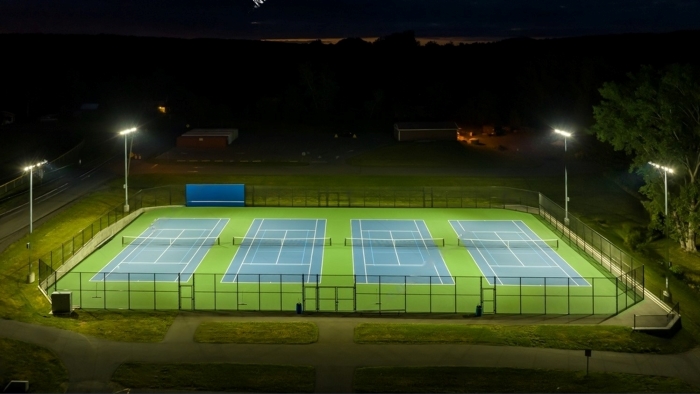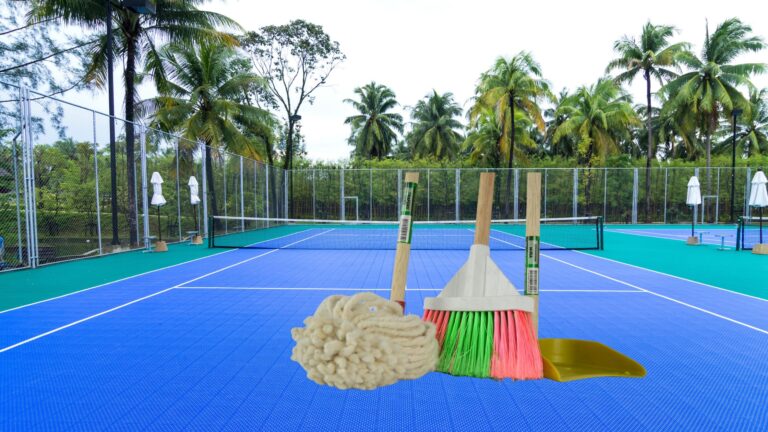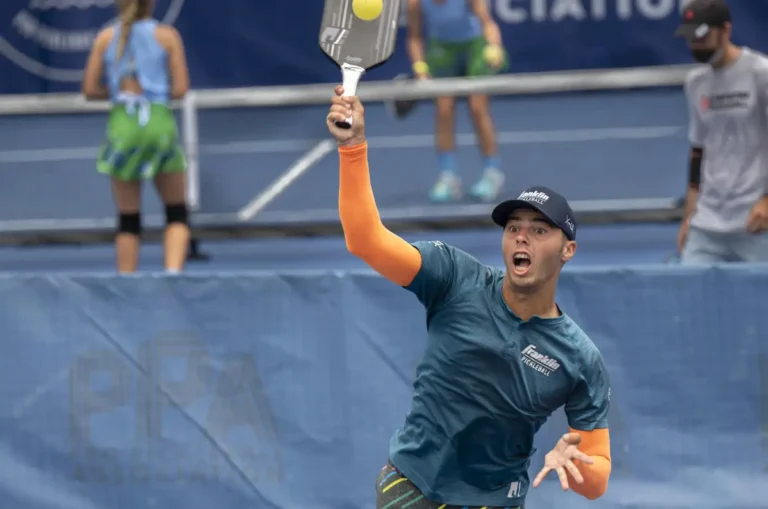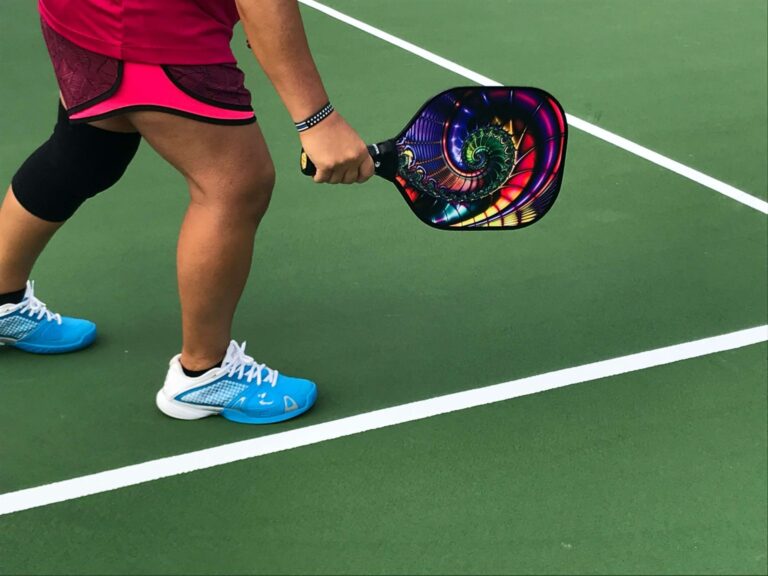Essential Pickleball Footwork Drills to Elevate Your Game: Techniques and Tips for All Skill Levels
Master essential pickleball footwork drills to boost your game! Perfecting your footwork enhances agility, speed, and shot accuracy—key for dominating the court. In this guide, discover techniques and drills tailored for all skill levels, from beginners to competitive players, to help you maneuver efficiently and react swiftly during play. Explore practical drills like ladder and cone drills, and learn to master the split step and crossover moves
Key Takeaways
To significantly enhance your pickleball performance, focus on mastering essential footwork drills:
- Shuffle and Lateral Steps: Improve lateral agility for better balance and swift reaction during rallies.
- Split Step: Enhance reaction time with quick directional changes following a small hop as the opponent strikes the ball.
- Cone Drills: Boost ability to swiftly change direction by weaving through a zigzag or linear pattern of cones.
- Ladder Drills: Develop rapid and precise footwork with speed ladder exercises to improve coordination and agility.
- Shadow Drills: Simulate game movements without a ball to internalize movement patterns and improve court awareness.
- Dinking Drill: Focus on precision and control with soft shots at the net, vital for volley exchanges.
- Third Shot Drop: Master this crucial transition shot from the baseline to the non-volley zone to set up points effectively.
- Avoiding common mistakes like improper stance and slow foot movement is crucial for optimal performance.
Regular practice of these drills targeting agility, precision, and speed will make you a formidable competitor on the court.
Why Mastering Footwork is Crucial in Pickleball
Pickleball is a game of rapid exchanges, where the ball can zip across the court at blistering speeds. Agility and speed are essential to keep up with the pace and respond to your opponent’s moves. Proper footwork enables you to change directions quickly, accelerate, and decelerate with precision, giving you a competitive edge on the court.
Moreover, footwork directly impacts your shot placement and court coverage. By maintaining a balanced and stable stance, you can generate more power and accuracy in your shots, allowing you to strategically place the ball in challenging positions for your opponents. Effective footwork also ensures that you can cover more court area, reaching those seemingly unreachable shots and putting pressure on your opponents.
Key Footwork Techniques Every Player Should Know
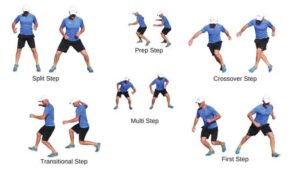
Before diving into drills, let’s explore the foundational footwork techniques that every pickleball player should master:
Ready Position
The ready position is the starting point for all movement on the court. It involves standing with your knees slightly bent, weight evenly distributed on the balls of your feet, and your dominant foot slightly ahead of the other. This athletic stance allows for quick reactions and efficient weight transfer, enabling you to explode in any direction promptly.
Split Step
The split step is a crucial technique that primes your body for movement. As your opponent strikes the ball, you’ll perform a small hop, landing with your weight evenly distributed on both feet. This motion engages your muscles and prepares you to quickly change directions, ensuring you’re ready to react to the incoming shot.
Lateral and Shuffle Steps
Lateral and shuffle steps are essential for maintaining your position on the court and covering side-to-side movements. To execute a lateral step, push off from your outside foot and bring your inside foot across, keeping your body low and centered. Shuffle steps involve quickly sliding your feet in a shuffling motion, allowing you to cover short distances rapidly.
Crossover Steps
Crossover steps are vital for quickly covering longer distances diagonally across the court. To perform a crossover step, bring your lead foot across your body, followed by your trailing foot in the desired direction. This technique allows for efficient and rapid court coverage, enabling you to reach those challenging shots.
Essential Footwork Drills for Beginner to Intermediate Players
Now that you’ve mastered the fundamental footwork techniques, let’s dive into some drills to help you reinforce and refine these skills.
Ladder Drills
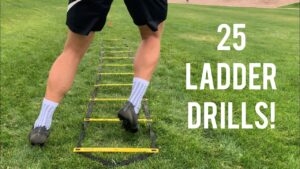
Imagine stepping into a world where you’re as agile as a gazelle, your feet dancing across the court with lightning speed. That’s the magic of ladder drills. By strategically placing a ladder (or lines) on the ground, you’ll perform a series of intricate footwork patterns, challenging your coordination and quickness.
As you hop in and out of the ladder’s rungs, side-stepping and shuffling with precision, you’ll feel your feet becoming lighter, your reactions sharper. It’s like unlocking a secret superpower, one that will have you gliding across the court with effortless grace.
Here’s a simple ladder drill to get you started:
- Set up a speed ladder or create lines on the ground with tape.
- Start at one end of the ladder, feet together.
- Step into the first rung with your right foot, followed by your left foot into the same rung.
- Quickly step your right foot into the next rung, then your left foot.
- Continue this pattern, moving as quickly as possible while maintaining proper form.
- Once you reach the end, turn around and repeat in the opposite direction.
| Ladder Drill Variations |
|---|
| Lateral steps |
| Crossover steps |
| High knees |
| Backwards movements |
Mixing up these variations will challenge different aspects of your footwork and keep your muscles guessing.
Cone Drills
Cones may seem like humble markers, but in the realm of pickleball, they’re the unsung heroes of footwork training. Strategically placed across the court, these vibrant sentinels challenge you to weave and navigate through their maze, honing your lateral and explosive movements.
Imagine yourself as a pickleball ninja, dashing from cone to cone, your feet a blur as you change directions with lightning speed. With each drill, you’ll feel your agility and quickness soaring, transforming you into a court-dominating force to be reckoned with.
Here’s a simple cone drill to try:
- Set up 4-6 cones in a straight line, spaced about 3-4 feet apart.
- Start at one end of the line, facing the first cone.
- Shuffle laterally to the first cone, then quickly change direction and shuffle to the next cone.
- Continue this pattern, moving as quickly as possible while maintaining proper form.
- Once you reach the end, turn around and repeat in the opposite direction.
| Cone Drill Variations |
|---|
| Zig-zag patterns |
| Crossover steps |
| Add a dribbling motion |
| Incorporate spins |
Mixing up these variations will challenge your footwork in new and exciting ways, keeping your muscles engaged and your mind sharp.
Shadow Drills
Sometimes, the greatest battles are fought within ourselves. Shadow drills are the ultimate test of your mental fortitude and muscle memory. Without the distraction of a ball, you’ll focus solely on perfecting your footwork, mimicking the movements of a pickleball master.
As you glide across the court, your feet tracing intricate patterns, you’ll find yourself in a meditative state, honing your technique with each step. It’s a journey of self-discovery, where you’ll learn to trust your body’s instincts and harness the power of visualization – a secret weapon that will give you an edge on the court.
Here’s a simple shadow drill to get you started:
- Step onto the pickleball court and assume the ready position.
- Visualize your opponent hitting a shot to your forehand side.
- Respond by taking the appropriate steps to reach the imaginary ball, executing a forehand shot.
- Repeat this process, visualizing shots to different areas of the court and responding with the correct footwork and swing.
| Shadow Drill Variations |
|---|
| Add dinks and volleys |
| Incorporate split steps |
| Mimic game situations |
| Incorporate verbal cues |
These variations will help you develop muscle memory, anticipation, and the ability to quickly transition between shots, all while honing your footwork skills.
Advanced Drills for Competitive Players
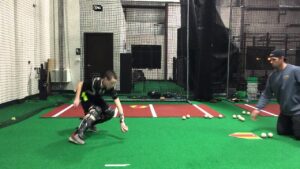
For those who have mastered the fundamentals and crave a greater challenge, these advanced drills will push your footwork skills to new heights, preparing you for the rigors of competitive play.
Here’s the full article continued:
Dinking Drill
Ah, the dink – a delicate yet deceptively challenging shot that requires precision and control. The dinking drill is a true test of your footwork mastery, as you’ll find yourself dancing at the net, your feet a whirlwind of shuffles and side-steps.
Imagine yourself as a pickleball pugilist, trading dink shots with your partner in a rhythmic exchange of finesse and strategy. With each volley, you’ll refine your balance, anticipation, and split-second reactions, transforming you into a net-dominating force to be reckoned with.
Here’s how to set up a dinking drill:
- Position yourself and your partner at the non-volley zone line (NVZ), facing each other.
- Start by gently dinking the ball back and forth, focusing on keeping it low and within the NVZ.
- As you become more comfortable, challenge each other by varying the dink’s placement, forcing your partner to move laterally or diagonally.
- Incorporate split steps and quick shuffles to maintain a balanced stance and respond effectively to each dink.
| Dinking Drill Variations |
|---|
| Add depth to the dinks |
| Alternate forehand/backhand dinks |
| Incorporate spins |
| Play out rallies after the dinking exchange |
These variations will not only test your footwork but also your touch, anticipation, and strategic thinking, preparing you for those intense net battles.
Third Shot Drop Drill
They say the third shot is the most crucial in pickleball, a make-or-break moment that can shift the game’s momentum. The third shot drop drill is your chance to hone this pivotal skill, mastering the art of the soft, arcing shot that controls the tempo of the game.
As you practice this drill, you’ll feel your footwork and shot placement meld into a harmonious dance, each step and swing a calculated move in a grander strategy. With every repetition, you’ll gain a deeper understanding of court positioning, shot selection, and the subtle nuances that separate the masters from the rest.
Here’s how to set up a third shot drop drill:
- Position yourself and your partner at opposite baselines.
- One player serves or drops the ball to initiate the rally.
- After the return, the receiving player must execute a well-placed third shot drop into the opposing court’s NVZ.
- Focus on proper footwork, balance, and weight transfer to generate a controlled, arcing shot.
- Switch roles after a predetermined number of successful drops.
| Third Shot Drop Drill Variations |
|---|
| Alternate sides of the court |
| Add depth to the third shot |
| Incorporate spins and angles |
| Play out rallies after the drop |
By mastering the third shot drop, you’ll gain a tactical advantage, dictating the pace of the game and forcing your opponents to make challenging shots.
Volley Drills
In the fast-paced world of pickleball, reflexes are king. Volley drills are the ultimate test of your hand-eye coordination and footwork agility, as you’ll find yourself reacting to rapid-fire shots, your feet a blur of movement.
Imagine yourself as a pickleball superhero, your senses heightened, your movements a blur as you anticipate each incoming shot, your feet guiding you to the perfect position. With each volley, you’ll feel your reflexes sharpen, your reactions becoming instinctive, transforming you into a court-dominating force to be reckoned with.
Here’s a simple volley drill to try:
- Position yourself and your partner at the NVZ line, facing each other.
- One player gently hits a volley to the other player’s forehand or backhand side.
- The receiving player must quickly move into position and return the volley, keeping the ball in play.
- Continue the volley exchange, focusing on quick footwork, balanced stances, and crisp volleys.
| Volley Drill Variations |
|---|
| Increase the pace |
| Incorporate spins |
| Add depth to the volleys |
| Play out rallies |
These variations will push your reaction time, coordination, and footwork to the limits, preparing you for those lightning-fast exchanges at the net.
Training Tips for Effective Footwork
Mastering footwork is a journey, and like any worthwhile endeavor, it requires dedication and the right approach. Here are some training tips to help you maximize the effectiveness of your footwork drills:
Consistent Practice
Rome wasn’t built in a day, and neither is pickleball prowess. Consistent practice is the key to ingrained muscle memory and sustained improvement. Set aside dedicated time each week to focus on footwork drills, treating them with the same importance as your regular game sessions.
It’s like cultivating a garden – with regular attention and care, your footwork skills will blossom into a magnificent display of agility and grace on the court.
Agility Exercises
While footwork drills are the bread and butter of your training regimen, incorporating agility exercises can supercharge your progress. Activities like jump ropes, plyometrics, and agility ladder workouts will complement your on-court training, enhancing your overall quickness, balance, and explosive power.
Think of it as cross-training for your feet – by challenging your body in different ways, you’ll develop a well-rounded foundation of strength and coordination, elevating your footwork to new heights.
Choosing the Right Footwear
Remember the age-old adage, “No matter how talented the dancer, they’re only as good as their shoes.” The same principle applies to pickleball. Investing in the right footwear can make a world of difference in your footwork performance.
Look for shoes designed specifically for court sports, with ample lateral support, cushioning, and traction. A good pair of pickleball shoes will not only enhance your movements but also help prevent injuries, ensuring you can continue strutting your stuff on the court for years to come.
It’s like having a loyal companion by your side – the right shoes will support you every step of the way, helping you navigate the court with confidence and ease. So, treat your feet like the champions they are, and they’ll reward you with exceptional footwork and longevity in the game.
Common Footwork Mistakes to Avoid
Even the most seasoned pickleballers can fall prey to common footwork mistakes that hinder their performance. Here are some pitfalls to watch out for and avoid:
- Improper Ready Position: Failure to maintain a balanced, athletic stance can lead to sluggish reactions and unstable movements.
- Flat-Footedness: Playing flat-footed or on your heels can severely limit your ability to change directions quickly and efficiently.
- Crossing Feet: Crossing your feet during movement can cause you to lose balance and stability, hindering your court coverage and shot execution.
- Slow Foot Movement: Hesitating or being slow to react can cost you valuable time and court position, leaving you vulnerable to your opponent’s shots.
- Lunging for Shots: Rather than taking proper steps, lunging for shots can throw off your balance and compromise your footwork.
By being mindful of these common mistakes and actively working to correct them, you’ll not only improve your footwork but also reduce the risk of injury and frustration on the court.
Footwork for Different Court Positions
Footwork techniques and drills can vary slightly depending on where you are positioned on the court. Let’s explore some position-specific tips:
At the Baseline
- Focus on lateral and crossover steps to cover wide angles
- Incorporate split steps to react quickly to serve returns
- Practice shadow drills mimicking baseline rallies
At the NVZ Line
- Mastering shuffle steps is crucial for quick lateral movements
- Work on quick split steps to transition from baseline to net
- Dinking and volley drills will reinforce footwork at the kitchen
At the Net
- Develop a light, balanced stance for effortless movement
- Dinking and quick volley exchanges require precise footwork
- Shadow net play to build muscle memory for court coverage
As a Singles Player
- Be prepared to cover more court area solo
- Crossover steps and diagonal movement are essential
- Practice full court drills that simulate game scenarios
Tailoring your training to the specific demands of each position will give you a well-rounded footwork skillset.
Footwork Mindset: The X-Factor
While technique and physical training are undoubtedly crucial, mastering the mental aspect of footwork can be a game-changer. Here are some mindset tips:
- Anticipation: Develop the ability to read your opponent’s body language and shot patterns, allowing you to position yourself proactively.
- Court Awareness: Maintain a keen sense of your court positioning and the ball’s trajectory, enabling you to make split-second decisions.
- Positive Self-Talk: Banish negative thoughts and self-doubt, replacing them with affirmations and a winning mindset that propels you forward.
Cultivating a strong footwork mindset will not only enhance your on-court performance but also contribute to your overall mental toughness as a competitor.
Footwork Challenges: Keeping it Fun
To prevent your training from becoming mundane, introduce some fun and engaging challenges to keep you motivated and competitive. Here are a few ideas:
- Footwork Relay Races: Divide into teams and compete in relay-style footwork drills, adding an element of friendly competition and camaraderie.
- Timed Challenges: Set a timer and see how many successful reps of a specific drill you can complete within the allotted time, pushing yourself to beat your personal records.
- Blindfolded Drills: Take your proprioception to the next level by practicing footwork drills while blindfolded, relying solely on your body awareness and muscle memory.
Injecting a dose of fun and creativity into your training routine can help you stay engaged, motivated, and excited about continuously improving your footwork prowess.
Footwork Heroes: Inspiration from the Pros
There’s no better way to learn than from the masters themselves. Studying the footwork techniques and movements of professional pickleball players can provide invaluable insights and inspiration. Here are a few footwork heroes to observe and emulate:
- Ben Johns: Known for his lightning-quick reflexes and impeccable court coverage, Ben Johns is a true footwork wizard on the pickleball court.
- Anna Leigh Waters: With her effortless glide and precise positioning, Anna Leigh Waters showcases the importance of fluid footwork in executing top-level shots.
- Tyson McGuffin: Tyson McGuffin’s explosive footwork and ability to change directions on a dime make him a formidable opponent at the net.
By analyzing the footwork patterns and strategies of these pros, you can gain a deeper understanding of how footwork can elevate every aspect of your game.
Remember, mastering footwork is a continuous journey, filled with challenges and opportunities for growth. Embrace the process, stay curious, and never stop pushing the boundaries of your abilities. With dedication and a passion for the sport, you’ll soon find yourself gliding across the court with the grace and agility of a true pickleball master.

